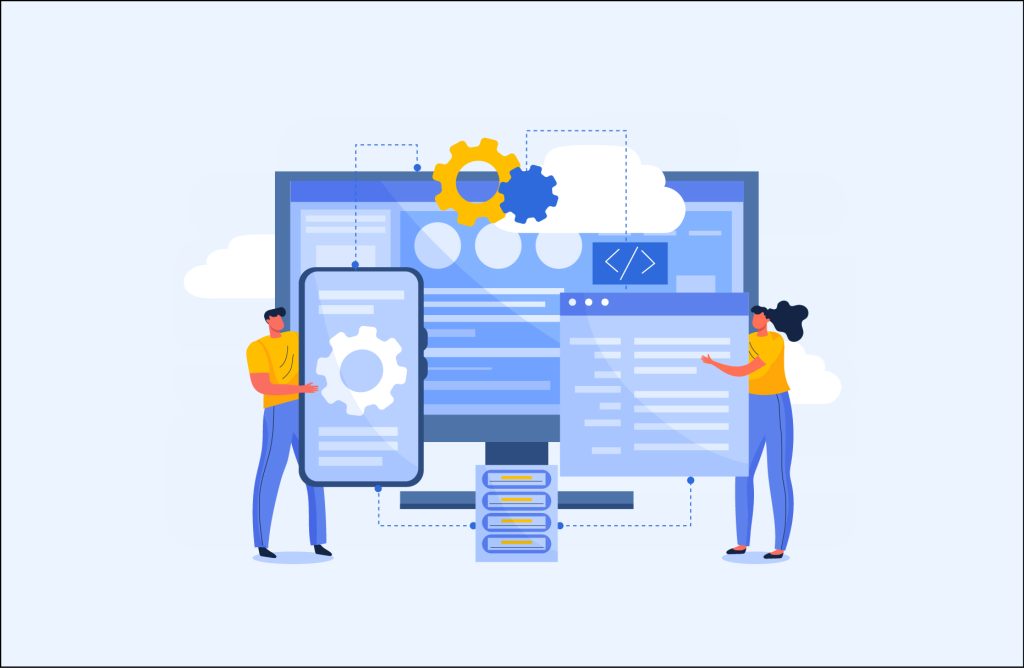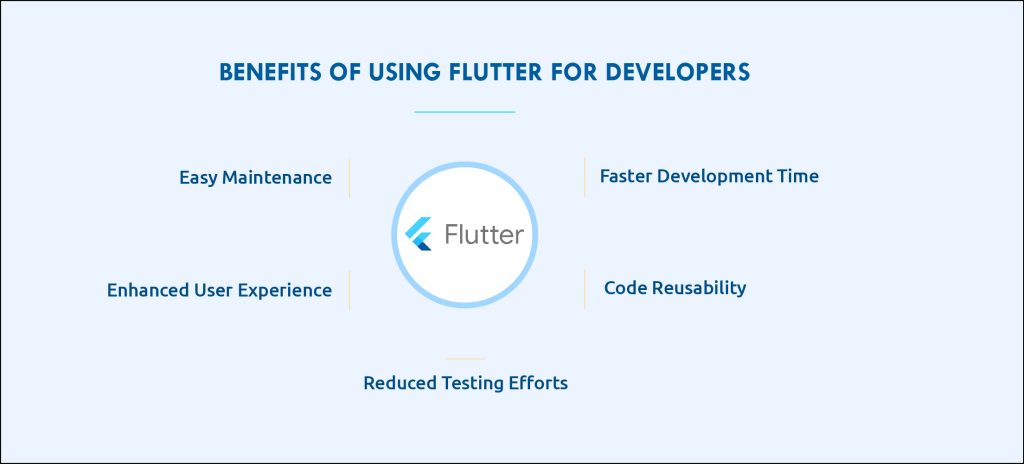BLOG
Introduction to Flutter: Unleashing Cross-Platform App Development
Developing apps for different platforms can be a time-consuming and costly endeavour.
Enter Flutter a robust cross-platform development framework that has gained significant popularity among developers and businesses alike.
In this blog post, we will introduce you to Flutter, explore its features and benefits, and shed light on why it is an excellent choice to build high-quality mobile applications.

What is Flutter?
Flutter is a tool that allows you to create native cross-platform applications with one programming language and one codebase.
Flutter is an open-source UI software development kit (SDK) developed by Google. It was released in May 2017 and has since gained traction in the developer community. Flutter provides a complete environment with a framework, widgets, and tools and allows you to compile your codebase into native machine code that runs on the platform.
Flutter enables developers to create high-performance, visually appealing, cross-platform mobile applications using a single codebase. It performs better than other cross-platform software like React Native.
Table of Content
- Flutter Vs React Native: Choosing The Right Framework For Your Mobile App
- Mobile App Development Process: 10 Mistakes To Avoid
- Accelerating Change: The Impact Of Mobile Applications On The Automotive Sector
- Leveraging Mobile Apps For Precision Agriculture And Crop Monitoring
- Full-Stack: The Key To Building Scalable And Agile Businesses
- A Step-By-Step Guide To Mobile App Development Process: Part 1
- A Step-By-Step Guide To Mobile App Development Part 2
- Mobile App Development: Unlocking The Power Of Technology For The Modern World
- 14 Must-Have Features For A Successful Mobile App In 2023
- The Ultimate Guide To UI/UX Transformation And Its Benefits For Businesses
What is Dart?
Flutter uses a programming language known as Dart, it helps in building Front-end user interfaces and front-end applications.
Dart helps you to create web and mobile applications and it is a class-based, object-oriented, and strongly typed programming language, Its syntax is like JavaScript or Java.
Flutter and Dart are two independent entities that work in a union. Flutter is a framework for Dart, and Dart uses Flutter’s capabilities to build the application.
Widgets
Widgets define the structure, layout, and behaviour of the UI elements in a Flutter application. Here are some commonly used Flutter widgets:
MaterialApp
MaterialApp is a widget that sets up the basic material design visual structure for an app. It provides a consistent look and feel across different platforms and includes features such as navigation, theming, and handling of device orientation changes.
Scaffold
Scaffold is a widget that implements the basic material design layout structure. It provides a framework for building the common elements of an application, such as app bars, navigation drawers, and floating action buttons.
Container
The container is a versatile widget that allows you to customize the visual properties of its child widget, such as its size, padding, margin, background colour, and borders. It is often used to create layout constraints and to style other widgets.
Column and Row
Column and Row are widgets used to arrange child widgets vertically and horizontally, respectively, and they provide flexible layout options, allowing you to specify how the child widgets should be positioned and aligned within the available space.
Text
Text is a widget to display a simple line of text. It allows you to customize the text style, such as the font, size, colour, and alignment.
Image
Image is a widget to display an image in a Flutter application, it supports various image formats and provides options for resizing, cropping, and applying filters to the image.
ListView
ListView is a widget to display a scrollable list of items. It is commonly used when you have several items to display in a limited space.
GestureDetector
GestureDetector is a widget to detect user gestures, such as taps, swipes, and long presses. It provides callbacks that can be used to handle different types of gestures.
FloatingActionButton
FloatingActionButton is a widget to display a floating action button and it is a prominent circular button typically used for primary actions in an application.
InkWell
InkWell is a widget to provide visual feedback when the user interacts with a widget, such as a tap or a long press. It can be used to add ripple effects or other visual animations.
These are just a few examples of the many widgets available in Flutter. The Flutter framework offers a wide range of widgets that allow developers to create highly customizable and interactive user interfaces for their applications.

Flutter Engine
Flutter Engine uses C++ and provides low-level rendering support with the help of Google’s Skia graphic library.
It combines with platform-specific SDKs that Android and iOS offer. The Flutter engine is a portable runtime that helps to host Flutter applications and its core libraries.
Flutter libraries include animation, graphics, fine and network input/output, accessibility support, plugin architecture, and a Dart runtime and Compile toolchain.
Features and Advantages of Flutter
Flutter offers several unique features and advantages that make it stand out among other mobile app development frameworks:
Hot Reload: With Flutter’s hot reload feature, developers can instantly see changes in the app during development, enabling faster iteration and reducing development time.
Expressive UI: Flutter provides a rich set of customizable widgets, allowing developers to create visually stunning and highly interactive user interfaces.
Dart Programming Language: The platform utilizes the Dart programming language, which offers a modern syntax, fast performance, and a growing community of developers.
Widgets: Flutter’s widget-based architecture enables developers to build complex and responsive UI components, facilitating a smooth user experience.
Platform-specific APIs and Services: Flutter provides access to platform-specific APIs and services, allowing developers to leverage native device functionalities seamlessly.
Access to Native Performance: Flutter apps can achieve native-like performance by directly compiling native code, resulting in smooth animations and fast rendering.
Benefits of Using Flutter for Developers
Flutter offers several benefits for developers:
Faster Development Time: With Flutter’s cross-platform capabilities, developers can build apps for iOS and Android simultaneously, reducing development time and effort.
Code Reusability: Flutter’s single codebase approach allows developers to write code once and deploy it across multiple platforms, maximizing code reuse and minimizing maintenance.
Reduced Testing Efforts: Since Flutter apps have consistent behaviour across devices, developers can focus on testing their apps on a single codebase, saving time and effort.
Enhanced User Experience: Flutter’s high-performance rendering engine enables developers to create fluid and responsive interfaces, delivering an exceptional user experience.
Easy Maintenance: Flutter’s reactive framework makes it easier to update and maintain apps, allowing developers to quickly implement bug fixes and add new features.

Business Benefits of Flutter
Businesses can reap several benefits from adopting Flutter for their mobile app development:
Cost Savings: Flutter’s cross-platform nature eliminates the need to develop separate apps for iOS and Android, resulting in significant cost savings.
Faster Time-to-Market: Using a single codebase businesses can accelerate app development and deployment, ensuring a faster time-to-market.
Improved User Engagement: Flutter’s expressive UI capabilities allow businesses to create visually appealing and intuitive interfaces, enhancing user engagement and satisfaction.
Seamless User Experience: Flutter apps offer consistent performance across different devices, ensuring a seamless user experience and reducing user frustration.
Increased Market Reach: With Flutter, businesses can target iOS and Android users, expanding their market reach and potential customer base.
Use Cases and Success Stories
Several companies have successfully leveraged Flutter for their mobile app development needs.
Here are some notable use cases and success stories of businesses that have embraced Flutter:
Google Ads: Google Ads, the advertising platform by Google, adopted Flutter to develop its mobile app. With Flutter’s cross-platform capabilities, Google Ads deliver a consistent and feature-rich experience to its users on iOS and Android platforms.
Alibaba: The e-commerce giant Alibaba utilized Flutter to build the Xianyu app, a popular consumer-to-consumer marketplace. Flutter enabled Alibaba to create a visually stunning and high-performance app that catered to the needs of millions of users.
BMW: The renowned automotive company BMW embraced Flutter to build its BMW Connected app. By using its cross-platform capabilities, BMW delivered a consistent user experience across various devices, enhancing the connectivity between the car and the app.
In conclusion, Flutter has emerged as a game-changing framework for mobile app development and Its ability to create visually appealing, high-performance and cross-platform applications makes it an ideal choice for small and medium-sized US companies.
By adopting this, businesses can save time and costs, reach a wider audience, and deliver exceptional user experiences.
Whether you are a developer or a business owner, considering Flutter for your mobile app development needs can unlock several possibilities and propel your digital presence to new heights.
Related Topics
Trending Topics
Want to build Super app for your business?



